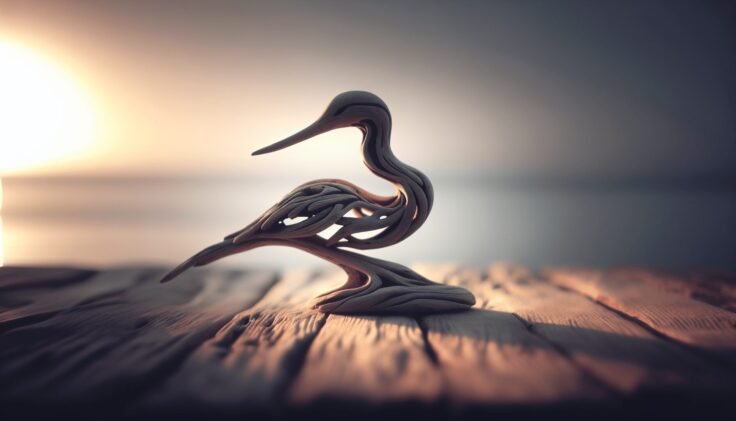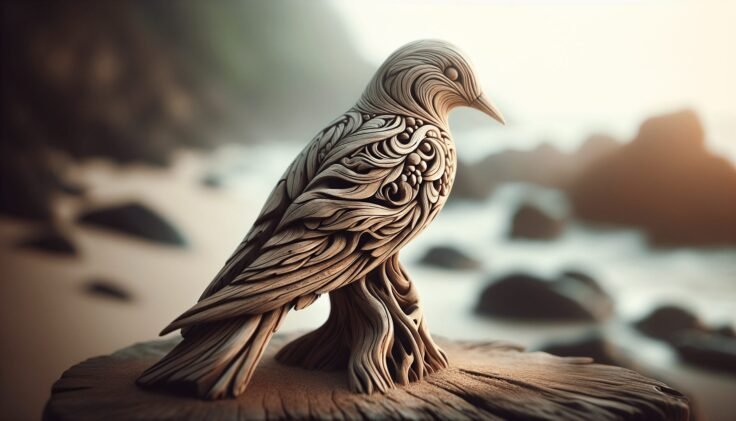Have you ever strolled along a beach, spot a piece of driftwood, and wondered what tales it might tell or the journey it has taken to land on the shore? The serene beauty of driftwood, shaped by the ocean’s currents and embraced by nature’s elements, provides a unique canvas for artistic endeavors. One such incredible form of art is Driftwood Bird Art. This fascinating genre brings together the raw beauty of driftwood with the intricate elegance of birds, creating stunning pieces that captivate the soul and spirit of every observer.
Understanding Driftwood Bird Art
What, exactly, is driftwood bird art? In essence, it’s a creative art form that transforms natural driftwood pieces into replicas or representations of birds. This art celebrates both the roughness of the wood and the delicacy of avian forms, resulting in sculptures that are both rustic and refined. Driftwood bird art is a delightful fusion, where the untamed beauty of nature meets the meticulous craft of sculpture.
The Appeal of Driftwood
Why use driftwood, you might ask? Driftwood has a compelling attraction due to its natural irregularities and distinctive textures. Each piece of driftwood is one-of-a-kind, shaped by waves and tides over time, leading to an unpredictability that invites creativity. Its organic texture—often worn smooth or pocked by the elements—adds character and charm to any piece, making it an ideal medium for artists seeking to capture the essence of species that are as varied and diverse as birds.
Birds: The Symbol of Freedom
Birds, on the other hand, have long been symbols of freedom, beauty, and transcendence across cultures worldwide. Recreating birds through driftwood not only captures their physical likeness but also embodies their free spirit. Many people find joy in these representations, as they serve as reminders of the beauty and grace found in nature.
The Origins of Driftwood Bird Art
Let’s take a step back into the origins and understand how this branch of art emerged. Driftwood has always been a source of fascination and utility, from ancient times when it was used as a basic construction material to modern usages like home decor. The craft of creating art – especially bird sculptures – began as artisans and hobbyists alike started exploring the potential of driftwood’s unique shapes.
Historical Context
Driftwood art, in general, can be traced back to cultures that lived close to water bodies and used resources available to them in all facets of life. These early forms of driftwood creations were often functional but laid the groundwork for the aesthetic exploration we see today. Through the ages, as communities began valuing art for expression and aesthetic pleasure rather than purely functional purposes, driftwood’s raw beauty attracted artists aiming to showcase nature in its most rugged form.
Evolution into Bird Art
Focusing specifically on birds came about likely due to the affinity people have with these creatures. Across various cultures, birds are seen as messengers or carriers of good omens. By embodying these creatures in physical form using materials gifted by nature, artists created a bridge bringing together eco-conscious practices and tradition. Contemporary driftwood bird art now spans a broad spectrum, from realistic depictions of specific bird species to abstract representations that capture a bird’s spirit.

Creating Driftwood Bird Art
You might be considering how these magnificent pieces come to life. The process of creating driftwood bird art is a harmonious combination of creativity, skill, and a deep appreciation for nature. Artists must select the right pieces of driftwood, consider the characteristics of both the wood and the bird, and use the appropriate tools to bring their vision to life.
Choosing the Right Driftwood
Selecting the right piece of driftwood is crucial. Artists look for pieces that naturally resemble some features of the bird they want to portray, perhaps a beak, wing, or tail. The wood’s natural lines and shapes guide the crafting process. It might surprise you how a piece of driftwood can already hold the semblance of a bird waiting to be unveiled.
Tools and Techniques
Different techniques and tools are employed in making driftwood bird art. Basic tools may include saws, sandpaper, drills, chisels, and sometimes a wood-burning tool for adding finer details. Various joining methods are used to piece together different parts of driftwood, perhaps nails, dowel rods, or glue. Creativity in using these tools and techniques means no two pieces are ever identical.
The Role of Finishing Touches
Once the driftwood sculpture begins to resemble its avian subject, artists often add finishing touches. You could use paint sparingly to highlight features or leave the wood bare to enhance its organic appeal. Some artists incorporate other natural materials like stones, feathers, or other found objects, enhancing the lifelike quality or abstractness of the bird art.
Appreciating the Art
Just as important as creating is understanding how to appreciate driftwood bird art. Whether you’re an artist or an admirer, recognizing the elements that make this form unique will deepen your appreciation and understanding of the craft.
Recognizing Artistic Elements
Start by examining the driftwood piece itself. Look for how the artist has used the existing texture and form to integrate the bird’s characteristics. Notice if the sculpture aims for realism, or if it invokes something more imaginative. Appreciate the movement captured within the form, which can often evoke a sense of flight or the quiet stillness of a bird at rest.
Understanding Symbolism
Every piece holds more than visual appeal. Birds are laden with symbolism throughout history and culture. A representation of a soaring eagle might mean inspiration and freedom, whereas a tiny sparrow could evoke simplicity and quiet beauty. Appreciating these symbolic interpretations adds another layer of depth to your engagement with this art form.

Driftwood Bird Art in Interior Design
Incorporating driftwood bird art into interior spaces bridges natural beauty with indoor comforts. The rustic, earthy tone of driftwood instinctively warms a room and adds an element of nature to any decor style, from modern minimalist to cozy rustic.
Placement Tips
Placing a piece of driftwood bird art involves considering lighting, height, and viewpoint. These pieces can become a room’s focal point; thus, placing them eye-level ensures they draw the attention intended. Consider how light affects the appearance of the driftwood and experiment by positioning your art where shadows can play, enhancing its three-dimensional nature.
Complementing Your Decor
The versatility of driftwood bird art allows for creative expression in various spaces. Pair these pieces with neutral colors to maintain focus on the art, or use them to complement nature-inspired interiors, involving other natural textures, such as woven tapestries, leafy plants, or stone features. The bird art acts as both a highlight and a subtle homage to the natural world.
The Benefits of Driftwood Bird Art
Adorning your home with driftwood bird art isn’t mere decoration. It also encapsulates sustainable practices and offers a range of aesthetic and emotional benefits.
Sustainability and Eco-Friendliness
Creating art from driftwood is an eco-conscious effort, recycling materials naturally provided and enhanced by the earth. It aligns with sustainable living principles. With growing environmental awareness, supporting artists who choose to work with driftwood encourages responsible art practices that repurpose rather than consume.
Emotional and Mental Well-Being
Surrounding yourself with art instills an sense of peace and inspiration. Driftwood bird art, in particular, brings a soothing connection to nature, essential for good mental well-being. Imagine the calming presence of a sculpted heron or the vibrant energy a colorful driftwood hummingbird can add to your daily life.
Growing Your Collection
For enthusiasts or collectors, driftwood bird art is a rewarding pursuit. Whether you purchase directly from artists or explore crafting your own pieces, curating a collection offers personal satisfaction and enriches your surroundings.
Supporting Local Artists
When collecting driftwood bird art, consider purchasing from local artisans. Supporting these creators fosters community art scenes and ensures their unique talents continue to flourish. Discovering new artists can be an adventure of its own, enriching your collection with diverse styles and interpretations.
DIY Art Pieces
If you’re keen on taking a creative leap yourself, making your driftwood bird art can be rewarding. Many hobbyists find joy not just in crafting but in the act of sourcing driftwood along the beaches or riversides. Creating your project not only results in a personal art piece but also contributes meaningfully to your environment, increasing your appreciation for this art form.
In conclusion, driftwood bird art is more than just art; it is a reflection of nature’s artistry and the human desire to connect deeply with the world around us. Each piece resonates with stories of the sea, the earth, and the skies, holding within them a timeless passage of nature’s beauty transformed by human hands. Whether you’re a creator or a collector, exploring this art form is a journey worth taking, and you’ll find that every piece has a story just waiting to be told.